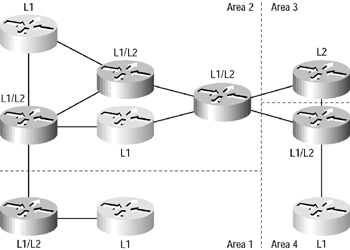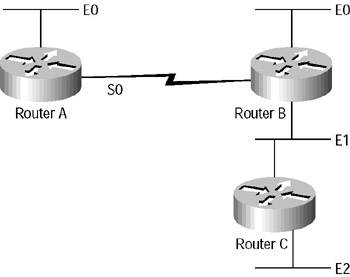Intermediate System - to - Intermediate System (IS-IS)
|
Intermediate System–to–Intermediate System (IS-IS)
In recent years, the Intermediate System–to–Intermediate System (IS-IS) routing protocol has become increasingly popular, with widespread usage among ISPs. IS-IS is a link-state protocol that enables very fast convergence with large scalability.
Features of IS-IS include
-
Hierarchical routing
-
Classless behavior
-
Rapid flooding of new information
-
Flexible timer tuning
IS-IS uses a two-level hierarchy to support large routing domains. A large domain may be administratively divided into areas. Each system resides in exactly one area. Routing within an area is referred to as Level 1 routing. Routing between areas is referred to as Level 2 routing. A Level 2 Intermediate System (IS) keeps track of the paths to destination areas. A Level 1 IS keeps track of the routing within its own area. For a packet destined for another area, a Level 1 IS sends the packet to the nearest Level 2 IS in its own area, regardless of what the destination area is. Then the packet travels via Level 2 routing to the destination area, where it may travel via Level 1 routing to the destination. Figure 9.3 shows how with IS-IS, an individual router is in only one area and the border between areas is on the link that connects two routers that are in different areas. This is in contrast to OSPF in which the area borders are within the ABRs.

Figure 9.3: IS-IS areas with Level 1 and Level 2 routing
A Level 1/Level 2 (L1/L2) router may have neighbors in any area. It has two link-state databases: a Level 1 link-state database for intra-area routing and a Level 2 link-state database for inter-area routing. A Level 1/Level 2 router runs two SPFs and may require more memory and processing power.
When designing a network, care should be taken to choose the correct setting: Level 1, Level 2, or Level 1/Level 2. When IS-IS is configured on a Cisco router, the default setting is Level 1/Level 2.
Configuring IS-IS for IP on Cisco Routers
IS-IS is an International Organization for Standardization (ISO) dynamic routing specification described in ISO 10589. The Cisco implementation of IS-IS allows you to configure IS-IS as an IP routing protocol.
To configure IS-IS, you need to consider the following list of tasks. Enabling IS-IS and assigning areas is required; the remaining tasks are optional, although you might need them depending upon your specific application:
-
Enabling IS-IS and assigning areas (required)
-
Enabling IP routing for an area on an interface (optional)
-
Configuring IS-IS interface parameters (optional)
-
Configuring miscellaneous IS-IS parameters (optional)
-
Monitoring IS-IS (optional)
In addition, you can filter routing information and specify route redistribution.
| Note | The optional IS-IS configurations are covered in much more depth in CCNP/ CCIP: BSCI Study Guide, also by Sybex. |
Enabling IS-IS and Assigning Areas
Enabling IS-IS requires that you create an IS-IS routing process and assign it to a specific interface. You can specify more than one IS-IS routing process per Cisco router using the multi-area IS-IS configuration syntax. You then configure the parameters for each instance of the IS-IS routing process.
Small IS-IS networks are built as a single area that includes all the routers in the network. As the network grows larger, it is usually reorganized into a backbone area made up of the connected set of all Level 2 routers from all areas, which in turn is connected to the local areas. Within a local area, routers know how to reach all system IDs. Between areas, routers know how to reach the backbone, and the backbone routers know how to reach other areas.
Routers establish Level 1 adjacencies to perform routing within a local area (intra-area routing). Routers establish Level 2 adjacencies to perform routing between Level 1 areas (inter-area routing).
Cisco routers are used to interconnect each area to the Level 2 backbone. In general, each routing process corresponds to an area. By default, the first instance of the routing process configured performs both Level 1 and Level 2 routing. You can configure additional router instances, which are automatically treated as Level 1 areas. You can configure a process to perform Level 1 routing at the same time. If Level 2 routing is not desired for a router instance, remove the Level 2 capability using the is-type command. Use the is-type command also to configure a different router instance as a Level 2 router.
You must configure the parameters for each instance of the IS-IS routing process individually. Network entity titles (NETs) define the area addresses for the IS-IS area and the system ID of the router.
Table 9.4 lists the commands you use to enable IS-IS and to specify the area for each instance of the IS-IS routing process.
| Command | Purpose |
|---|---|
| Router(config)#router isis [area tag] | Enables IS-IS routing for the specified routing process and places the router in configura tion mode. Use the area tag to identify the area to which this IS-IS router instance is assigned. A value for tag is required if you are configuring multiple IS-IS areas. |
| Router(config)# net network-entity-title | Configures NETs for the routing process. |
IS-IS allows you to alter certain interface-specific parameters. Most interface configuration commands can be configured independently from other attached routers. The isis password command should configure the same password on all routers on a network. The settings of other commands (isis hello-interval, isis hello-multiplier, isis retransmit-interval, isis retransmit-throttle-interval, isis csnp-interval, and so on) can be different on different routers or interfaces. However, if you decide to change certain values from the defaults, it makes sense to configure them on multiple routers and interfaces. Referring to the following example and to Figure 9.4, you can see how IS-IS configuration is performed:
Router_A(config)router isis Router_A(config-router)net 49.0001.0000.0000.000a.00 Router_A(config-router)interface ethernet 0 Router_A(config-if)ip router isis Router_A(config-if)interface serial 0 Router_A(config-if)ip router isis Router_B(config)router isis Router_B(config-router)net 49.0001.0000.0000.000b.00 Router_B(config-router)interface ethernet 0 Router_B(config-if)ip router isis Router_B(config-if)interface ethernet 1 Router_B(config-if)ip router isis Router_B(config-if)interface serial 0 Router_B(config-if)ip router isis Router_C(config)router isis Router_C(config-router)net 49.0001.0000.0000.000c.00 Router_C(config-router)interface ethernet 1 Router_C(config-if)ip router isis Router_C(config-if)interface ethernet 2 Router_C(config-if)ip router isis

Figure 9.4: IS-IS area and NET configuration
|
EAN: 2147483647
Pages: 201